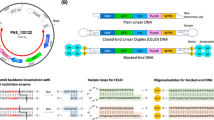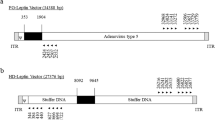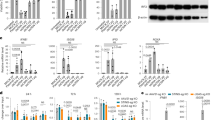Abstract
A novel approach to nonviral DNA delivery is the use of combinations of DNA-binding proteins such as the yeast transcriptional activator GAL4 and plasmid DNA containing the specific binding sequence of the DNA-binding protein inserted within it, in addition to the gene of interest to be transferred into target cells. The amino terminal 147 amino acids of GAL4 contain a DNA-binding domain that has been shown to bind specifically to a 17 bp nucleotide recognition sequence, while the amino terminal 74 amino acids have been shown to be sufficient to target large heterologous proteins to the nucleus. Although it has been previously exploited as a gene transfer vehicle, the exact relationship between GAL4’s DNA binding and nuclear targeting activities has not been investigated. Using gel mobility shift assays and ELISA-based binding assays, this study examines this issue directly, establishing the mutual exclusivity of the DNA-binding and nuclear targeting activi- ties of GAL4. We demonstrate that GAL4(1–147) can specifically enhance transfection of plasmids containing the 17 bp recognition sequence. Interestingly, we found that the nuclear localization signal (NLS) of GAL4 is distinct from conventional NLSs, such as those of the SV40 large tumor antigen and bipartite NLSs, in that it is recognized exclusively by the nuclear pore targeting β-subunit of the NLS-receptor importin complex, rather than the α-subunit. Specific binding to DNA was blocked by β-subunit binding, while the converse was also true, making the GAL4-NLS novel in being regulated by DNA binding; this may play an important role in effecting release of GAL4 from the β-subunit following transport through the nuclear pore. This study encompasses the first direct analysis of NLS recognition/accessibility in vehicles for nonviral DNA transfer, with the results having relevance to the use of GAL4 and comparable DNA-binding proteins in such vehicles.
This is a preview of subscription content, access via your institution
Access options
Subscribe to this journal
Receive 12 print issues and online access
$259.00 per year
only $21.58 per issue
Buy this article
- Purchase on Springer Link
- Instant access to full article PDF
Prices may be subject to local taxes which are calculated during checkout
Similar content being viewed by others
Author information
Authors and Affiliations
Rights and permissions
About this article
Cite this article
Chan, C., Hübner, S., Hu, W. et al. Mutual exclusivity of DNA binding and nuclear localization signal recognition by the yeast transcription factor GAL4: implications for nonviral DNA delivery. Gene Ther 5, 1204–1212 (1998). https://doi.org/10.1038/sj.gt.3300708
Received:
Accepted:
Published:
Issue Date:
DOI: https://doi.org/10.1038/sj.gt.3300708
Keywords
This article is cited by
-
The chimeric multi-domain proteins mediating specific DNA transfer for hepatocellular carcinoma treatment
Cancer Cell International (2016)
-
A nuclear targeting system in Plasmodium falciparum
Malaria Journal (2010)
-
Identification and functional analysis of NOL7 nuclear and nucleolar localization signals
BMC Cell Biology (2010)
-
Nuclear entry of nonviral vectors
Gene Therapy (2005)
-
Imaging analysis of mineralocorticoid receptor and importins in single living cells by using GFP color variants
Cell and Tissue Research (2005)



